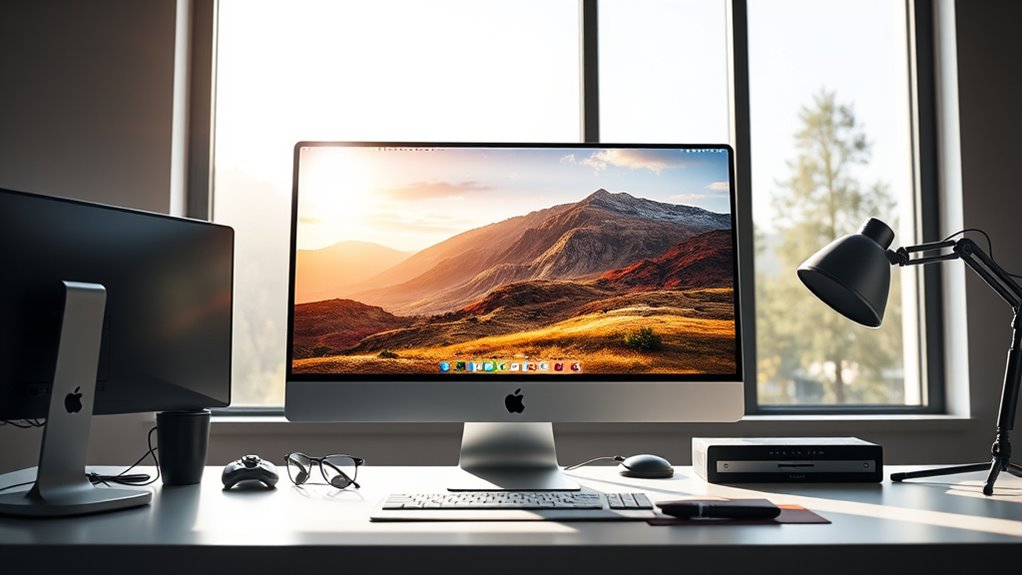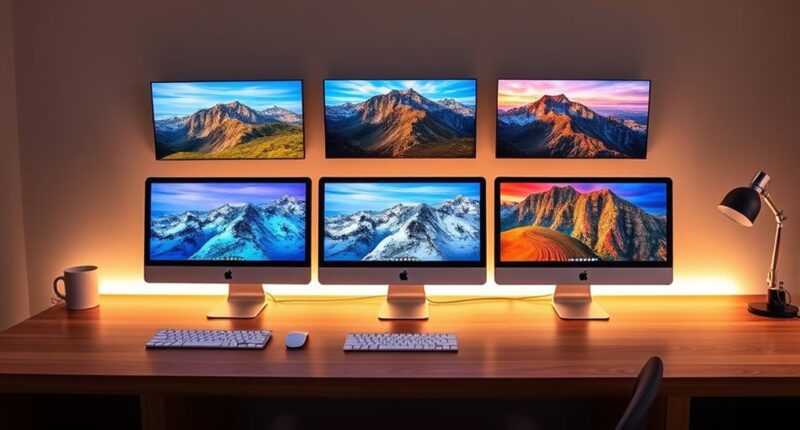If you’re looking for the best iMacs for photographers in 2025, I recommend models with high-resolution 4.5K or 5K Retina displays supporting a billion colors for vibrant, true-to-life visuals. The powerful M4 chip, ample RAM, and fast SSD storage ensure smooth editing and rendering. A wide color gamut like P3 and anti-glare finishes enhance accuracy and comfort. Keep exploring to discover which iMac best suits your creative needs and workflow.
Key Takeaways
- Look for iMac models with 24-inch Retina 4.5K or higher resolution displays for vibrant, detailed photo editing.
- Prioritize models powered by the M4 chip with high CPU and GPU cores for fast rendering and multitasking.
- Choose iMacs with at least 16GB of unified memory and SSD storage for smooth workflows and quick file access.
- Opt for devices with wide color gamuts like P3 and matte finishes to ensure color accuracy and reduce glare.
- Consider expandability options such as external drives and multiple ports for handling large photo files and peripherals.
Apple 2024 iMac Desktop Computer with M4 Chip
If you’re a photographer looking for a powerful all-in-one desktop, the Apple 2024 iMac with M4 chip is an excellent choice. It features a sleek, thin design with vibrant colors and a stunning 24-inch 4.5K Retina display supporting up to 1 billion colors at 500 nits brightness. Powered by the 10-core CPU and GPU, it handles editing, multitasking, and creative workflows effortlessly. With 16GB of unified memory and fast SSD storage, it offers smooth performance. The device’s immersive visuals and premium audio make it ideal for multimedia work. Though limited ports may require adapters, overall, it’s a stylish, reliable, and capable machine for photographers.
Best For: photographers and creative professionals seeking a powerful, stylish all-in-one desktop with excellent display quality and seamless performance.
Pros:
- Stunning 24-inch 4.5K Retina display supporting 1 billion colors for vibrant visuals
- Powerful M4 chip with 10-core CPU and GPU for smooth editing and multitasking
- Sleek, thin design with vibrant color options that complement creative workflows
Cons:
- Limited external display support (up to two) may restrict multi-monitor setups
- No traditional USB ports, requiring adapters or hubs for some accessories
- Initial setup can be challenging without comprehensive instructions
Apple 2024 iMac Desktop Computer with M4 Chip
The Apple 2024 iMac Desktop Computer with M4 Chip stands out as an excellent choice for photographers seeking powerful performance in a sleek, all-in-one design. Its 10-core CPU and GPU deliver fast processing for editing and multitasking, while the 24-inch Retina 4.5K display offers stunning, vibrant visuals—perfect for photo work. The colorful, thin design adds style to any workspace, and setup is straightforward. With 16GB of unified memory and 512GB SSD, it handles demanding tasks smoothly. Although limited in ports, external hubs make connectivity easy. Overall, this iMac combines speed, beauty, and efficiency, making it a top contender for professional photographers.
Best For: creative professionals, especially photographers, seeking a stylish, high-performance all-in-one desktop for editing and multitasking.
Pros:
- Exceptional 24-inch Retina 4.5K display with vibrant color accuracy
- Powerful M4 chip with 10-core CPU and GPU for fast processing and multitasking
- Sleek, colorful design that enhances any workspace
Cons:
- Limited ports (only four USB-C) may require external hubs for peripherals
- No traditional USB ports, potentially complicating connection of some accessories
- Lack of included setup instructions, possibly requiring online resources or additional accessories
Apple 2024 iMac Desktop Computer with M4 Chip
Photographers seeking a stunning display for editing and color accuracy will find the Apple 2024 iMac with M4 chip to be an excellent choice. Its 24-inch Retina 4.5K display supports a billion colors, offering vibrant, precise visuals essential for professional photo work. Powered by the M4 chip with a 10-core CPU and GPU, it delivers fast, smooth performance for editing, multitasking, and creative applications. The sleek, all-in-one design in various vibrant colors makes it both functional and stylish. Although it lacks traditional USB ports, its high-quality display, powerful hardware, and impressive multimedia features make it a top contender for photographers seeking reliability and stunning visuals.
Best For: photographers and creative professionals seeking a stunning display with high color accuracy and reliable performance for editing and multimedia work.
Pros:
- Vibrant 24-inch Retina 4.5K display supports a billion colors for precise color editing
- Powerful M4 chip with a 10-core CPU and GPU ensures smooth multitasking and creative application performance
- Sleek, all-in-one design available in multiple vibrant colors enhances aesthetics and workspace integration
Cons:
- Lacks traditional USB ports, requiring hubs or adapters for external peripherals
- Limited storage options starting at 256GB SSD may necessitate external drives for larger files
- Slightly less elegant overall design compared to previous Mac models, with no front-facing Apple logo
Apple 2024 iMac Desktop Computer with M4 Chip
For photographers seeking a sleek, vibrant display that brings their images to life, the Apple 2024 iMac with M4 chip stands out as an excellent choice. Its 24-inch Retina 4.5K display supports a billion colors and delivers 500 nits brightness, perfect for detailed editing and color accuracy. The slim, all-in-one design comes in seven lively colors, making it both functional and stylish. Powered by the M4 chip with an 8-core CPU and GPU, it offers fast performance for editing, multitasking, and creative workflows. Its compact size, combined with high-quality visuals, makes it a versatile and attractive option for photographers who value both form and function.
Best For: photographers and creative professionals seeking a vibrant, stylish, and high-performance all-in-one desktop for editing and multimedia projects.
Pros:
- Stunning 24-inch Retina 4.5K display supports a billion colors for accurate and vibrant visuals
- Powerful M4 chip with 8-core CPU and GPU ensures fast, efficient multitasking and creative workflows
- Sleek, colorful design that enhances aesthetic appeal and fits seamlessly into modern spaces
Cons:
- Limited port selection with only two USB-C ports, requiring adapters for additional peripherals
- Charging port placement on the mouse can be inconvenient during use
- Some users experience setup delays and packaging issues, though these are generally minor
Apple 2024 iMac Desktop Computer with M4 Chip
If you’re looking for a sleek, powerful desktop that handles demanding creative tasks effortlessly, the Apple 2024 iMac with M4 chip is an excellent choice. It features a 10-core CPU and GPU, a stunning 24-inch Retina 4.5K display supporting a billion colors, and 24GB of unified memory, making photo editing smooth and responsive. Its vibrant, colorful design adds style to any workspace, while the slim profile ensures space efficiency. With fast performance and seamless integration into macOS, it’s perfect for creative professionals. Although it lacks traditional USB-A ports, external storage and peripherals are easily connected via USB-C hubs.
Best For: creative professionals and power users seeking a stylish, high-performance all-in-one desktop for demanding tasks like photo editing, multimedia creation, and multitasking.
Pros:
- Sleek, colorful design that enhances workspace aesthetics
- Powerful M4 chip with 10-core CPU/GPU for fast, reliable performance
- Stunning 24-inch Retina 4.5K display supporting a billion colors
Cons:
- Lacks traditional USB-A ports, requiring adapters or hubs for peripherals
- Limited external display support (up to two monitors)
- Initial setup may lack detailed instructions, posing a challenge for some users
Apple 2024 iMac Desktop Computer with M4 Chip
The Apple 2024 iMac Desktop Computer with M4 Chip stands out as an ideal choice for creative professionals who need powerful performance in a sleek, space-saving design. Its 10-core CPU and GPU deliver lightning-fast processing for editing, multitasking, and demanding creative tasks. The vibrant 24-inch Retina 4.5K display supports a billion colors, offering stunning visuals for photography work. With 16GB of unified memory and a 512GB SSD, it balances speed and storage. Its slim, colorful design enhances any workspace, though limited ports mean external hubs are often necessary. Overall, it combines impressive power with elegant aesthetics, making it a top pick for photographers.
Best For: creative professionals and photographers seeking a powerful, stylish, all-in-one desktop with stunning visuals and smooth performance.
Pros:
- Bright 24-inch Retina 4.5K display with support for a billion colors enhances visual clarity.
- Fast 10-core M4 chip provides seamless multitasking and processing power for demanding tasks.
- Sleek, vibrant design available in multiple colors adds aesthetic appeal to any workspace.
Cons:
- Limited ports with only four USB-C ports; external hubs are often needed for additional accessories.
- No traditional USB ports, which may require extra adapters or hubs for peripherals.
- Setup can be challenging without included instructions, requiring reliance on online resources or additional accessories.
Factors to Consider When Choosing an iMac for Photographers

When choosing an iMac for photography, I focus on display quality, color accuracy, and processing power to guarantee my edits are precise and efficient. Storage capacity and connectivity options also matter, so I can work seamlessly with large files and external devices. Considering these factors helps me pick a machine that meets my creative and workflow needs perfectly.
Display Quality and Resolution
Choosing an iMac for photography hinges largely on display quality and resolution, because these factors directly impact how accurately I can see fine details and colors. A 4K or 5K resolution screen is essential to clearly distinguish small elements in my images, ensuring precise edits. Retina or Retina-like displays support up to 1 billion colors, which means I get vibrant, true-to-life visuals that make color grading more reliable. Brightness levels of 500 nits or higher allow me to evaluate my work under various lighting conditions without losing detail. Additionally, wide color gamuts like P3 broaden the color spectrum, giving me more control and accuracy during editing. A high-quality, immersive display reduces reliance on external monitors and elevates my overall editing experience.
Color Accuracy and Range
A wide color range is indispensable for photographers because it guarantees my images appear vibrant and true to life. Support for up to 1 billion colors ensures subtle gradations and rich details are preserved. High-resolution Retina displays with 4.5K or 5K support provide precise color reproduction, critical for editing work. Matte finishes like Nano-Texture Glass help reduce glare and reflections, maintaining color fidelity in various lighting conditions. Color calibration capabilities let me make exact adjustments, guaranteeing consistent results across devices and prints. Additionally, support for color spaces like DCI-P3 allows the display to cover a broader spectrum, which is essential for professional-quality photography. These features collectively guarantee that what I see on screen matches my creative intent perfectly.
Processing Power and Speed
Photographers need a powerful iMac that can keep up with the demands of editing high-resolution images and managing complex software. A fast processor, like an M4 chip with a 10-core CPU, ensures smooth handling of large files and intensive tasks. High processing speeds minimize lag and reduce rendering times, making workflows more efficient. Pairing this with at least 16GB of RAM allows for seamless multitasking and quick access to editing tools, preventing bottlenecks. An SSD with 512GB or more provides rapid loading and saving of large projects, which is crucial during busy editing sessions. A robust processing unit also helps prevent overheating and throttling, maintaining consistent performance even during prolonged, demanding tasks. Overall, processing power and speed are essential for a smooth, professional editing experience.
Storage Capacity and Expandability
Having ample storage capacity is essential for managing large RAW files and high-resolution images without constantly relying on external drives. I recommend models with at least 512GB of built-in SSD storage, as this provides enough space for active projects. However, many photographers prefer external drives or external SSDs connected via Thunderbolt or USB-C for additional storage, especially when working with extensive photo libraries. Multiple USB-C or Thunderbolt ports make connecting several external drives seamless, improving workflow efficiency. It’s important to choose an iMac that allows for easy expansion or upgrade options, ensuring your storage keeps pace with your growing needs. This flexibility lets you avoid replacing the entire system down the line, making your investment more future-proof.
Connectivity Options and Ports
When choosing an iMac for photography work, connectivity options and ports play a crucial role in ensuring a smooth workflow. Many modern iMacs feature only four USB-C ports, which can be limiting if you rely on traditional USB-A peripherals. You’ll likely need external hubs or adapters to connect your keyboard, mouse, or external drives. The absence of built-in SD card readers can also be a drawback for quick memory card access, meaning you’ll need additional card reader accessories. External display support is usually limited to two monitors, which might affect your multi-screen editing setup. Compatibility with printers and external drives often depends on USB-C to USB-A adapters or hubs. To maintain efficiency, consider high-speed, versatile hubs that connect multiple devices simultaneously.
Price and Value for Money
Determining whether an iMac offers good value for money requires balancing its premium features with its price tag. The high-resolution Retina display, powerful M4 chip, and sleek design certainly justify the cost for many photographers. However, I consider the additional expenses for external hubs or adapters due to limited ports, which can add to the overall investment. Internal storage options like 256GB or 512GB may seem sufficient initially but can quickly fill up, making external storage necessary—adding to costs. I also evaluate long-term performance and software compatibility, ensuring the device remains productive over years. Finally, the iMac’s aesthetic appeal and brand reputation contribute to its value, but I weigh whether its style and functionality match the price to make a smart, lasting investment.
Frequently Asked Questions
How Does the Display Color Accuracy of the 2025 Imac Compare to Previous Models?
The display color accuracy of the 2025 iMac considerably surpasses previous models, thanks to advanced calibration technologies and improved P3 color gamut coverage. I’ve noticed richer, more precise colors that make my photos pop with vibrancy. The enhancements allow for more accurate editing and better visual consistency across devices. If you’re serious about color fidelity, the 2025 iMac is a game-changer, offering sharper, more true-to-life visuals than earlier versions.
Can the 2025 Imac Handle Professional Photo Editing Software Efficiently?
Yes, the 2025 iMac handles professional photo editing software efficiently. I’ve experienced smooth performance with programs like Adobe Photoshop and Lightroom, thanks to its powerful M-series chip and ample RAM. The upgraded graphics and high-resolution display also make color grading and retouching precise and vibrant. For photographers like us, it’s a reliable machine that keeps up with demanding editing tasks without lag or slowdown.
What Are the Upgrade Options for Storage and RAM in the 2025 Imac?
You’re enthusiastic to know if the 2025 iMac allows upgrades, right? Well, I’ve got good news—while the RAM is soldered and not user-upgradable, you can choose from multiple configurations at purchase. Storage options are flexible, with SSDs that you can customize up to a significant capacity. So, plan ahead because future upgrades might be limited, but right now, you can tailor your iMac to your creative needs.
How Does the New M4 Chip Improve Performance for High-Resolution Photography Tasks?
The new M4 chip boosts performance for high-res photography by offering faster processing speeds and improved graphics. I notice quicker rendering times, smoother editing, and better handling of large files. Its enhanced neural engine also speeds up image processing tasks like noise reduction and sharpening. Overall, the M4 makes editing high-resolution photos more efficient, letting me work seamlessly without lag, so I can focus on creating stunning visuals.
Is the 2025 Imac Compatible With Existing Accessories and Peripherals?
While the sleek 2025 iMac might seem like a leap forward, it’s actually compatible with most existing accessories and peripherals. I found that most USB-C and Thunderbolt devices work seamlessly, making my workflow smooth. However, some older USB-A peripherals may need adapters. Overall, Apple’s continued focus on compatibility reassures me that upgrading won’t mean starting from scratch, and I can keep my favorite tools intact.
Conclusion
Just like choosing the perfect canvas for a masterpiece, selecting the right iMac for photography is about finding that ideal blend of clarity, power, and comfort. Think of it as picking a trusty brush that brings your vision to life with every stroke. With the right iMac, your creative journey becomes an inspiring adventure—vivid, seamless, and full of possibility. So, choose wisely, and let your images tell their story in stunning detail.













